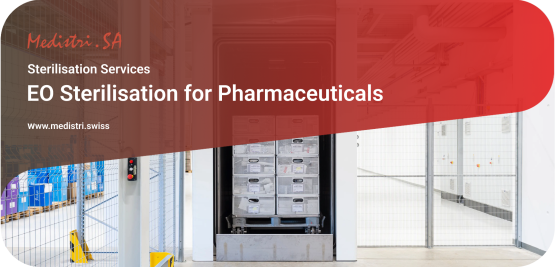(Download: EO Sterilisation for Pharmaceuticals in PDF by Medistri)
Sterilisation is a crucial process in the pharmaceutical industry to ensure the safety and efficacy of drugs and medical devices. Ethylene oxide (EO) sterilisation is one of the most widely used methods for sterilising pharmaceutical products.
EO Sterilisation is a process that uses ethylene oxide gas to kill microorganisms on medical devices, pharmaceutical products, and other materials. The process involves exposing the product to EO gas in a sealed chamber, where the gas penetrates the product and kills any microorganisms present. EO sterilisation is effective against a wide range of microorganisms, including bacteria, viruses, and fungi.
EO Sterilisation of pharmaceutical preparations intended for either parenteral, ocular, implantation, or any specific use is a mandatory clinical and regulatory requirement. Any pharmaceutical dosage form must be pyrogen-free as well as meet the pharmaceutical quality standards as described in pharmacopeias and to be safe for the intended purpose of use.
The EO Sterilisation process helps in making the formulation free from any type of contaminants, pyrogen, microbes, and microbial spores. The presence of a contaminant may degrade the desired product; this is common in bacterial contamination of antibiotic fermentations where the contaminant may have to be resistant to the normal inhibitory effects of the antibiotic and degradation of the antibiotic is a common resistance mechanism.
1. Preconditioning: The product to be sterilized is placed in a sealed chamber and exposed to a controlled humidity and temperature to prepare it for the sterilisation process.
2. Sterilisation: The EO gas is introduced into the chamber, and the product is exposed to the gas for a specific period of time. The gas penetrates the product and kills any microorganisms present.
3. Aeration: After the sterilisation process is complete, the chamber is vented to remove the EO gas. The product is then aerated for a specific period of time to remove any residual gas and reduce the levels of EO to safe levels.
4. Testing: The product is then tested to ensure that it has been effectively sterilised and that the levels of EO are within safe limits.
👉 The sterilisation process is carefully monitored and controlled to ensure that the product is not damaged or compromised during the process. The equipment used for the EO Sterilisation is designed to maintain precise conditions of temperature, humidity, and gas concentration to ensure that the process is effective and safe.
EO Sterilisation is a highly effective method for sterilising pharmaceutical products, but it requires careful planning.
ISO 11335 is the international standard that details the development and validation of a process for sterilizing medical devices using ethylene oxide.
Ethylene oxide has been used for sterilization since the 1940s. One of the primary reasons for EO’s popularity is its ability to penetrate plastic packaging and sterilize the devices inside. Of course, it’s impossible to verify that each device has been appropriately sterilized without opening the package and rendering the product unsterile once again.
👉 That’s why ISO 11135 exists. It provides guidance on how to validate the sterilization process. Once the process as a whole has been validated, the medical device manufacturer, regulatory bodies, and end users can be confident that the final product is sterile.
Ethylene oxide has an amazing ability to penetrate plastic barriers and kill microorganisms—known as the “bioburden”—that may be present within packaging, tubing, or other nooks and crannies within a device.However, EO is also highly flammable and carcinogenic, meaning there are a number of precautions and measures that must be taken to ensure that it is used safely.
For instance, due to EO’s flammable nature, the sterilization chamber is maintained at a sub-atmospheric pressure, generally below six pounds per square inch absolute (psia).
ISO 11135 breaks down the ethylene oxide sterilization process into three stages:
- Preconditioning.
- Sterilization.
- Aeration.
Medistri SA is equipped with 5 EO Sterilisation chambers each with capacities up to 16 palettes. Our chambers have been engineered to allow you to sterilise loads up to 200cm of height, allowing you to maximise the size of your final production loads, and reduce costs. Medistri can currently sterilise more than 73'000 palettes annually using its EO sterilisation infrastructure. And we're always working towards making this number larger.
🎯 To learn more about Medistri’s EO Sterilisation, visit on our website at www.medistri.swiss or directly contact our team at contact@medistri.swiss.
- The Medistri Team
#Medistri
